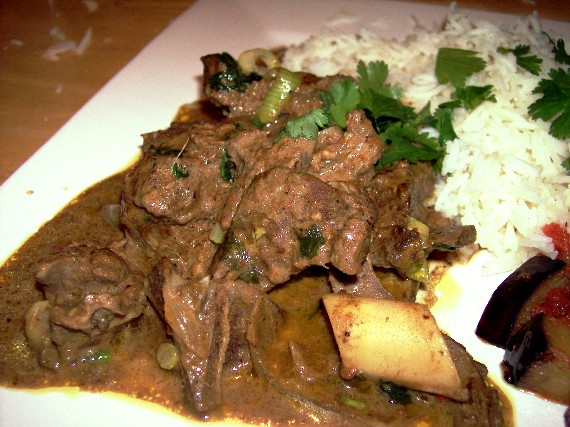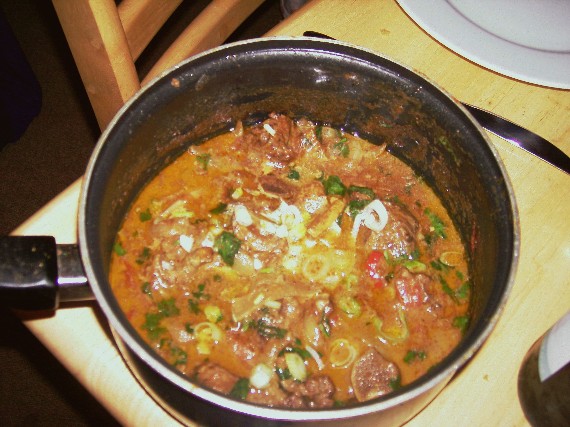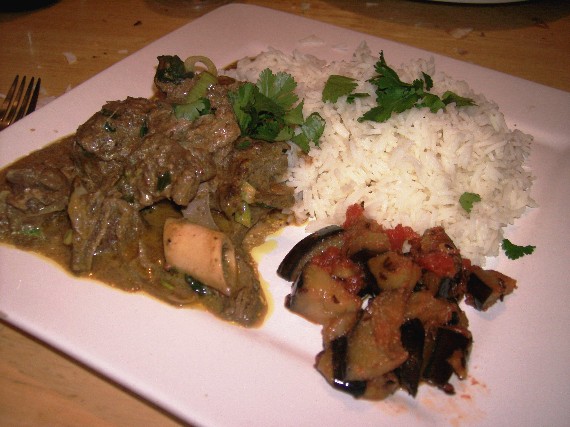

For many years now, James has been telling me stories about how his father, a security guard at Aldershot Army Base, gets goat meat from the gurka’s staying there. Apparently these guys buy whole dead animals from the local farmers and then butcher them up themselves for curry. These stories always intrigued me and I wanted to try curry goat myself.
My experience of Nepalese food has been limited to a single restaurant on the Uxbridge Road in Shepherds Bush. It certainly is good and, while I lived near it, I would visit it on almost a weekly basis after late night rehearsals. The cuisine is very similar to North Indian cuisine, with some curries that are mild and creamy and some so hot they’d strip your tongue of tastebuds! I was always rather disappointed that goat curry was never on the menu.
It wasn’t until Franka at Can Cook must Cook mentioned Trinidadian curry goat that I suddenly realised I had a hope of finding goat meat in London. Franka pointed me in the direction of Shepherds Bush market so, on my first free Saturday, I wandered over. It didn’t take me long to find a small butchers advertising curry goat in the window for a mere £2.99 per kilo. There were other interesting looking things there too, including whole oxtails and a sheep’s head. I made a mental note to come back from some of the goat leg (again cheap at £1,89 per kilo) and the oxtail.
Even though goat meat is very rarely eaten in Britain it is an extremely popular meat in some other areas of the world. Despite this, I seemed to find it difficult to get some good information about cooking it. The best I could find, was one line in a Wikipedia article stating that the meat should be cooked long and slow. After doing a bit of research on the spices involved I came up with this plan:
- Fry off some finely diced onions, garlic and red chilli, add ground cumin and coriander, garam masala, minced garlic, ginger and fennel seed.
- Brown the goat in the spices, cover with water and leave to simmer gently for three hours.
- Shortly before the goat has cooked, roast some more coriander and cumin seed and make a curry powder of these and fennel seed.
- Remove goat from liquid and keep warm. Boil the liquid repidly to reduce it.
- Fry some more onion, garlic and ginger. Add curry powder, more garam masala, a little tomato and chopped coriander. Add reduced goat stock, simmer for a bit, taste and adjust seasoning. Stir the meat in, warm through, top with sliced spring onion and serve over boiled rice with a vegetable curry and lentils.
That is pretty much how it worked in the end, except that, on tasting it, I decided it needed a touch of cream, to make it like the lamb curry I had in the last nepalese restaurant I visited. I’m not sure how authentic that was but it made a big difference to my curry.

The pieces of meat labeled ‘curry goat are obviously the spare bits as they had a fair bit of bone in them and a little gristle but the meat itself was gorgeous. The flavour was very much like mutton but much more rich. The three hour simmer had done it good and the meat melted in the mouth.

I decided to make an aubergine, chilli and tomato concoction to accompany my goat and also some tarka dahl and plain boiled basmati rice. It’s definitely a dish i’ll ake again, although I think Trinidadian curry goat has to be tried first.
For many years now, James has been telling me stories about how his father, a security guard at Aldershot Army Base, gets goat meat from the gurka’s staying there. Apparently these guys buy whole dead animals from the local farmers and then butcher them up themselves for curry. These stories always intrigued me and I wanted to try curry goat myself.
My experience of Nepalese food has been limited to a single restaurant on the Uxbridge Road in Shepherds Bush. It certainly is good and, while I lived near it, I would visit it on almost a weekly basis after late night rehearsals. The cuisine is very similar to North Indian cuisine, with some curries that are mild and creamy and some so hot they’d strip your tongue of tastebuds! I was always rather disappointed that goat curry was never on the menu.
It wasn’t until Franka at Can Cook must Cook mentioned Trinidadian curry goat that I suddenly realised I had a hope of finding goat meat in London. Franka pointed me in the direction of Shepherds Bush market so, on my first free Saturday, I wandered over. It didn’t take me long to find a small butchers advertising curry goat in the window for a mere £2.99 per kilo. There were other interesting looking things there too, including whole oxtails and a sheep’s head. I made a mental note to come back from some of the goat leg (again cheap at £1,89 per kilo) and the oxtail.
Even though goat meat is very rarely eaten in Britain it is an extremely popular meat in some other areas of the world. Despite this, I seemed to find it difficult to get some good information about cooking it. The best I could find, was one line in a Wikipedia article stating that the meat should be cooked long and slow. After doing a bit of research on the spices involved I came up with this plan:
- Fry off some finely diced onions, garlic and red chilli, add ground cumin and coriander, garam masala, minced garlic, ginger and fennel seed.
- Brown the goat in the spices, cover with water and leave to simmer gently for three hours.
- Shortly before the goat has cooked, roast some more coriander and cumin seed and make a curry powder of these and fennel seed.
- Remove goat from liquid and keep warm. Boil the liquid repidly to reduce it.
- Fry some more onion, garlic and ginger. Add curry powder, more garam masala, a little tomato and chopped coriander. Add reduced goat stock, simmer for a bit, taste and adjust seasoning. Stir the meat in, warm through, top with sliced spring onion and serve over boiled rice with a vegetable curry and lentils.
That is pretty much how it worked in the end, except that, on tasting it, I decided it needed a touch of cream, to make it like the lamb curry I had in the last nepalese restaurant I visited. I’m not sure how authentic that was but it made a big difference to my curry.
The pieces of meat labeled ‘curry goat are obviously the spare bits as they had a fair bit of bone in them and a little gristle but the meat itself was gorgeous. The flavour was very much like mutton but much more rich. The three hour simmer had done it good and the meat melted in the mouth.
I decided to make an aubergine, chilli and tomato concoction to accompany my goat and also some tarka dahl and plain boiled basmati rice. It’s definitely a dish i’ll ake again, although I think Trinidadian curry goat has to be tried first.


